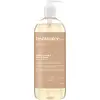What's inside
What's inside
 Key Ingredients
Key Ingredients

 Benefits
Benefits

 Concerns
Concerns

 Ingredients Side-by-side
Ingredients Side-by-side

Water
Skin ConditioningCoco-Glucoside
CleansingCocamidopropyl Betaine
CleansingSodium Coco-Sulfate
CleansingHoney
HumectantVanilla Planifolia Fruit Extract
Skin ConditioningButyrospermum Parkii Butter
Skin ConditioningOlea Europaea Fruit Oil
MaskingCocos Nucifera Oil
MaskingGlycerin
HumectantTocopherol
AntioxidantPolysorbate 80
EmulsifyingPotassium Sorbate
PreservativeSodium Benzoate
MaskingSodium Chloride
MaskingTetrasodium Glutamate Diacetate
Citric Acid
BufferingWater, Coco-Glucoside, Cocamidopropyl Betaine, Sodium Coco-Sulfate, Honey, Vanilla Planifolia Fruit Extract, Butyrospermum Parkii Butter, Olea Europaea Fruit Oil, Cocos Nucifera Oil, Glycerin, Tocopherol, Polysorbate 80, Potassium Sorbate, Sodium Benzoate, Sodium Chloride, Tetrasodium Glutamate Diacetate, Citric Acid
Sodium Lauroyl Isethionate
CleansingStearic Acid
CleansingSodium Palmitate
CleansingWater
Skin ConditioningLauric Acid
CleansingSodium Isethionate
CleansingSodium Stearate
CleansingCocamidopropyl Betaine
CleansingParfum
MaskingSodium Palm Kernelate
CleansingButyrospermum Parkii Butter
Skin ConditioningGlycerin
HumectantSodium Chloride
MaskingZinc Oxide
Cosmetic ColorantPropylene Glycol
HumectantTetrasodium EDTA
Tetrasodium Etidronate
Emulsion StabilisingAlumina
AbrasiveBenzyl Alcohol
PerfumingBenzyl Salicylate
PerfumingButylphenyl Methylpropional
PerfumingCoumarin
PerfumingHexyl Cinnamal
PerfumingLimonene
PerfumingLinalool
PerfumingCI 15985
Cosmetic ColorantCI 19140
Cosmetic ColorantCI 77891
Cosmetic ColorantSodium Lauroyl Isethionate, Stearic Acid, Sodium Palmitate, Water, Lauric Acid, Sodium Isethionate, Sodium Stearate, Cocamidopropyl Betaine, Parfum, Sodium Palm Kernelate, Butyrospermum Parkii Butter, Glycerin, Sodium Chloride, Zinc Oxide, Propylene Glycol, Tetrasodium EDTA, Tetrasodium Etidronate, Alumina, Benzyl Alcohol, Benzyl Salicylate, Butylphenyl Methylpropional, Coumarin, Hexyl Cinnamal, Limonene, Linalool, CI 15985, CI 19140, CI 77891
 Reviews
Reviews

Ingredients Explained
These ingredients are found in both products.
Ingredients higher up in an ingredient list are typically present in a larger amount.
This ingredient is also known as shea butter. It is an effective skin hydrator and emollient.
Emollients help soothe and soften your skin. It does this by creating a protective film on your skin. This barrier helps trap moisture and keeps your skin hydrated. Emollients may be effective at treating dry or itchy skin.
Shea butter is rich in antioxidants. Antioxidants help fight free-radicals, or molecules that may harm the body. It is also full of fatty acids including stearic acid and linoleic acid. These acids help replenish the skin and keep skin moisturized.
While Shea Butter has an SPF rating of about 3-4, it is not a sunscreen replacement.
Shea butter may not be fungal acne safe. We recommend speaking with a professional if you have any concerns.
Learn more about Butyrospermum Parkii ButterCocamidopropyl Betaine is a fatty acid created by mixing similar compounds in coconut oil and dimethylaminopropylamine, a compound with two amino groups.
This ingredient is a surfactant and cleanser. It helps gather the dirt, pollutants, and other impurities in your skin to be washed away. It also helps thicken a product and make the texture more creamy.
Being created from coconut oil means Cocamidopropyl Betaine is hydrating for the skin.
While Cocamidopropyl Betaine was believed to be an allergen, a study from 2012 disproved this. It found two compounds in unpure Cocamidopropyl Betaine to be the irritants: aminoamide and 3-dimethylaminopropylamine. High-grade and pure Cocamidopropyl Betaine did not induce allergic reactions during this study.
Learn more about Cocamidopropyl BetaineGlycerin is already naturally found in your skin. It helps moisturize and protect your skin.
A study from 2016 found glycerin to be more effective as a humectant than AHAs and hyaluronic acid.
As a humectant, it helps the skin stay hydrated by pulling moisture to your skin. The low molecular weight of glycerin allows it to pull moisture into the deeper layers of your skin.
Hydrated skin improves your skin barrier; Your skin barrier helps protect against irritants and bacteria.
Glycerin has also been found to have antimicrobial and antiviral properties. Due to these properties, glycerin is often used in wound and burn treatments.
In cosmetics, glycerin is usually derived from plants such as soybean or palm. However, it can also be sourced from animals, such as tallow or animal fat.
This ingredient is organic, colorless, odorless, and non-toxic.
Glycerin is the name for this ingredient in American English. British English uses Glycerol/Glycerine.
Learn more about GlycerinChances are, you eat sodium chloride every day. Sodium Chloride is also known as table salt.
This ingredient has many purposes in skincare: thickener, emulsifier, and exfoliator.
You'll most likely find this ingredient in cleansers where it is used to create a gel-like texture. As an emulsifier, it also prevents ingredients from separating.
There is much debate on whether this ingredient is comedogenic. The short answer - comedogenic ratings don't tell the whole story. Learn more about comegodenic ratings here.
The concensus about this ingredient causing acne seems to be divided. Research is needed to understand if this ingredient does cause acne.
Scrubs may use salt as the primary exfoliating ingredient.
Learn more about Sodium ChlorideWater. It's the most common cosmetic ingredient of all. You'll usually see it at the top of ingredient lists, meaning that it makes up the largest part of the product.
So why is it so popular? Water most often acts as a solvent - this means that it helps dissolve other ingredients into the formulation.
You'll also recognize water as that liquid we all need to stay alive. If you see this, drink a glass of water. Stay hydrated!
Learn more about Water